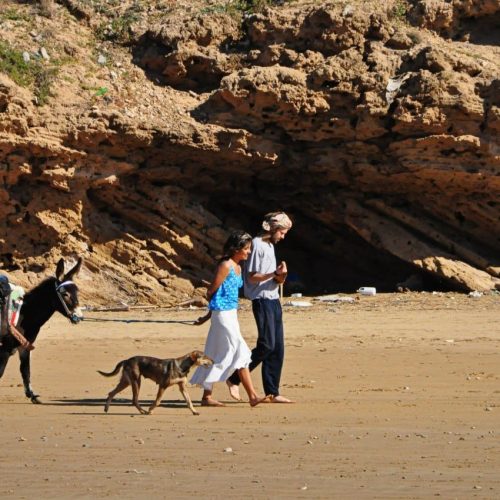
Moroccan cuisine is a vibrant tapestry of flavors, aromas, and textures, reflecting the country’s rich history and cultural diversity.
Surfing in Morocco has a rich and vibrant history that intertwines with the country’s stunning coastal landscape and its unique cultural heritage. While the sport as we know it today began to gain popularity in the mid-20th century, Morocco’s connection to the ocean dates back centuries, with fishing communities relying on the Atlantic for sustenance and livelihood.
Surfing in Morocco has a fascinating history marked by the convergence of culture, geography, and the global surf movement. The country’s extensive coastline, characterized by diverse wave conditions and stunning scenery, has positioned it as a premier surfing destination since the late 20th century.


While surfing as we know it today didn’t take root in Morocco until the mid-20th century, the region’s beaches had long been frequented by travelers and adventurers. In the 1960s, American and European surfers began to explore Morocco’s Atlantic coast, captivated by the unspoiled beauty and potential for excellent waves. Early surfers often camped along the coast, sharing their passion for the sport and introducing locals to surfing.
The 1970s marked a turning point as more surfers began to recognize Morocco’s surf potential. Taghazout, a small fishing village, became a focal point due to its consistent swells and famous surf spots like Anchor Point, known for its powerful left-hand break. During this period, the first surfboards were crafted locally, reflecting a growing interest in the sport among Moroccans.
By the 1980s, the Moroccan surf scene began to flourish. Locals started to embrace the sport, and surf schools began to emerge, catering to both tourists and aspiring local surfers. The influx of surf tourists provided economic opportunities for local communities, and surf-related businesses began to spring up, including rental shops and surf camps.
The local surf culture began to blend with traditional Moroccan customs, creating a unique environment where surfing was not only a sport but a lifestyle. The community also saw the first Moroccan surfers competing in international contests, gaining recognition and inspiring a new generation.
In the 1990s, Morocco became increasingly recognized on the international surfing scene. The surf competition circuit began to include events held in Morocco, attracting global surfers eager to experience the country’s waves. This decade saw the establishment of a more formalized surf culture, with increased investment in surf tourism infrastructure, such as hotels, restaurants, and surf schools.


The new millennium brought a surge in surf tourism, with Morocco emerging as a go-to destination for surfers from Europe, the United States, and beyond. The combination of warm waters, consistent surf, and a laid-back vibe made it especially appealing for those looking to escape colder climates.
During this time, Taghazout became synonymous with surf culture, hosting various international surf competitions and events. The annual “Taghazout Surf Festival” celebrated both local talent and international surfers, fostering a sense of community and camaraderie.
Surfing in Morocco has also played a role in promoting cultural exchange. Many surf schools and camps actively involve local communities, offering lessons that blend Moroccan traditions with modern surfing techniques. This fusion not only enriches the surfing experience but also empowers local youth through skills training and job opportunities in the surf tourism sector.
Environmental awareness has become an essential aspect of the surf community in Morocco, as surfers and local organizations work together to preserve the coastal environment. Initiatives focused on beach clean-ups, ocean conservation, and sustainable tourism practices are increasingly prominent.
Today, Morocco is renowned for its diverse surf spots, ranging from beginner-friendly beaches to challenging reef breaks. Essaouira, Agadir, and the less-explored areas of the coast like Mirleft and Imsouane have all developed unique surf communities.
Moroccan surfers are now competing at international levels, and the country hosts several high-profile competitions, attracting attention from the global surf community. The rise of local surf brands and the establishment of surf collectives have further solidified Morocco’s position in the surfing world.
The history of surfing in Morocco is a testament to the sport’s ability to transcend cultural boundaries, foster community, and stimulate economic growth. With its stunning coastline and rich cultural backdrop, Morocco continues to inspire surfers worldwide, ensuring its legacy in the global surfing narrative for years to come. As the surf scene evolves, it remains deeply intertwined with the local culture, reflecting a unique blend of tradition and modernity that characterizes this beautiful country. 🌅🏄♀️
#SurfingHistory #Morocco #Taghazout #SurfCulture #OceanAdventure

Moroccan cuisine is a vibrant tapestry of flavors, aromas, and textures, reflecting the country’s rich history and cultural diversity.

The Taghazout Surf Expo has become a symbol of Morocco's commitment to sustainable surf tourism, positioning Taghazout as a leading...

Moroccan cuisine Moroccan cuisine is a vibrant tapestry of flavors, aromas, and colors, deeply rooted in the country’s rich history...

### The History of Surfing in Morocco ????????♂️ Surfing in Morocco has a rich and vibrant history that intertwines with...

Discover the Perfect Surfing and Yoga Blend The unique combination of surfing and yoga available at Surf Discovery in Morocco...

Unleashing Your Potential: Surfing and Yoga Integration Surfing and yoga are two disciplines that seamlessly intertwine, creating a harmonious balance...
